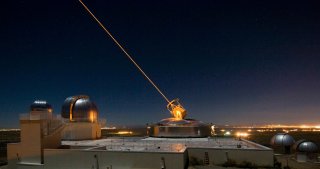Why Directed Energy Weapons are a Priority for the Department of Defense
Directed energy weapons won't replace kinetic weapons, but can complement them and help maintain technological superiority.
Earlier this month, Heidi Shyu, undersecretary of defense for research and engineering (OUSD(R&E)) at the United States Department of Defense (DoD), called for a National Defense Science and Technology strategy for the DoD. As part of the 2022 National Defense Strategy (NDS), the science and technology strategy would be structured around three strategic pillars: mission focus, foundation building, and succeeding through teamwork.
"This technology strategy will chart a course for the United States' military to strengthen its technological superiority amidst a global race for technological advantage," Shyu wrote in a memo. "To maintain the United States military's technological advantage, the Department will champion research, science, technology, engineering, and innovation."
One of the technologies that could help the U.S. maintain its technological superiority is directed energy (DE) – which the DoD defines as those using concentrated electromagnetic energy, rather than kinetic energy, to "incapacitate, damage, disable, or destroy enemy equipment, facilities, and/or personnel."
Building Trust in DE Capabilities
One issue hindering the development of DE is the current lack of trust. Joe Shepherd, vice president of directed energy innovation at Booz Allen Hamilton, said that there are a few steps the United States could take to change that mindset.
"There are DE systems today that have demonstrated the ability to address threats like UAVs, vehicle borne IEDs or various gray zone warfare threats better than any bullet or missile," Shepherd wrote in an email interview. "Giving warfighters the opportunity to test these systems and instill the necessary familiarity and trust to use them in operational missions can not only save lives, but also advance the field of directed energy with lessons learned and relevant tactics, techniques and procedures.”
Finding the right balance between speed of production and fielding, as well as effective engineering and technical maturation, could also be key to building that trust. It would also require a significant investment.
"Achieving this will require commensurate funding in the field: if the U.S. government increased its current level of funding of roughly $1 billion annually to $2 billion, it would radically transform industry’s ability to develop and field prototypes of these new technologies," Shepherd wrote. "We need to move past closed door testing and give directed energy technology advancement a spotlight. We must put these systems into the hands of warfighters so they can gain needed experience with this increasingly important class of weapons."
The Advantages and Challenges
This technology could offer significant advantages, which is why the United States isn't alone in developing DE weapons. As with hypersonic technology, quantum computing, and artificial intelligence (AI), it is yet another area where the U.S. can't afford to lag behind.
"As our adversaries rapidly develop next-generation offensive capabilities that can't be readily countered by kinetic means, such as hypersonic missiles or drone swarms, it's critical that the U.S. continue to invest in the development of effective defensive countermeasures," Shepherd said. "The defensive capabilities of directed energy will be an essential component of our national security architecture, but first we must invest in maturing the technology to bring it to bear against a growing range of existing and emerging threats."
Most worrisome is that the United States is now at risk of falling behind in developing next-generation military technology.
"Now is the time to drive the proper resources towards directed energy to prioritize speed, adoption, and building the needed trust from the operators that will one day use them in the field," Shepherd said. "It is also necessary that we build a robust, reliable and trusted supply chain for the development of directed energy systems."
Update to Existing Systems
Another issue is how DE weapons could be employed on existing platforms. It would be more than simply swapping out a tank's main gun for a new DE cannon. But as the technology matures, it will find a place on many weapon platforms.
It could even be one of the most significant upgrades in weapons technology since the introduction of smokeless powder in the nineteenth century.
"Directed energy is an entirely different class of weapon systems that complements traditional kinetic weapons in several ways," said Shepherd. "The continued technical maturation of directed energy technologies has demonstrated the ability to integrate these weapon systems onto or into multiple combat vehicles including ground, sea and air platforms. With the advancements being made in size, weight and power (SWaP) packaging and modularity, it is clear that directed energy systems can be configured to 'drop into' many of these platforms with limited impact to the vehicle's form, fit and function."
Moreover, DE may not actually replace current weapons, but complement them.
"In many cases, directed energy systems can be emplaced alongside kinetic weapons to compliment the overall combat effectiveness with both lethal and non-lethal effect," Shepherd said. "As more of these systems are developed and deployed operationally, it is certain we will realize substantial operations and sustainment cost savings over traditional kinetic weapons."
Peter Suciu is a Michigan-based writer who has contributed to more than four dozen magazines, newspapers and websites. He regularly writes about military small arms, and is the author of several books on military headgear including A Gallery of Military Headdress, which is available on Amazon.com.
Image: U.S. Air Force Flickr.
Image: Reuters.

